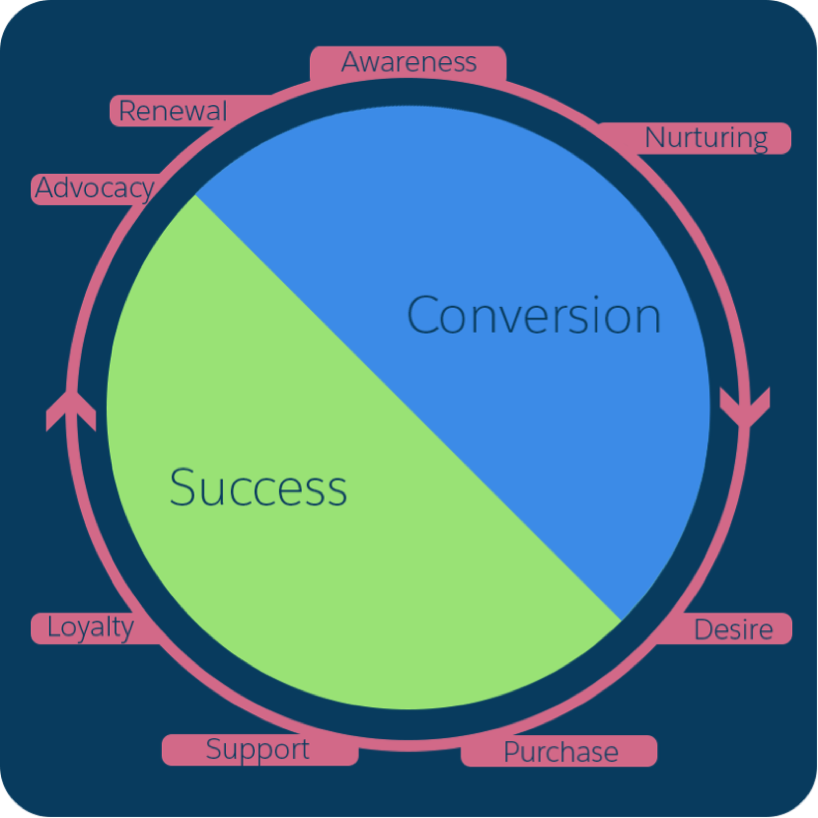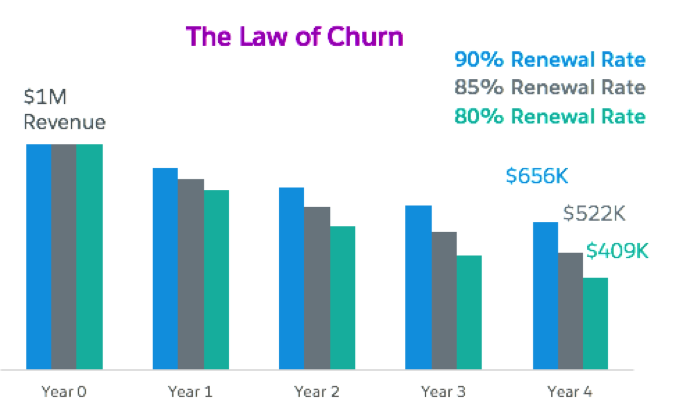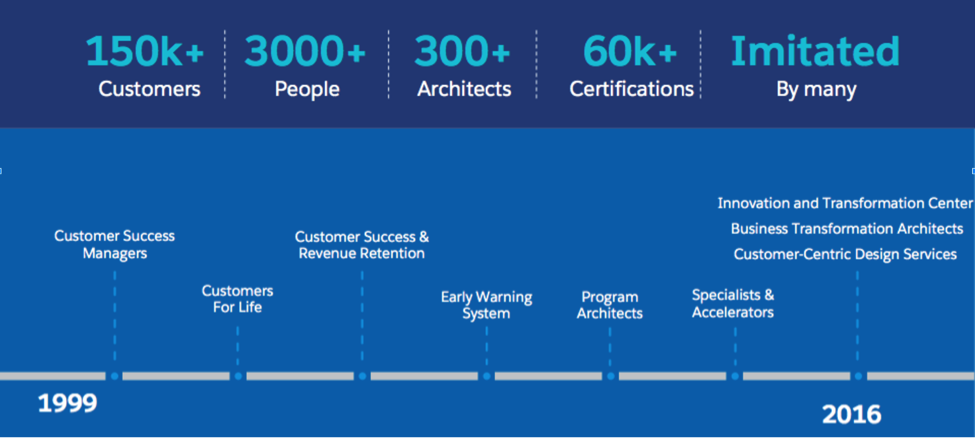Focus on the Customer
Learning Objectives
After completing this unit, you’ll be able to:
- Define customer success.
- Describe key customer success functions.
- Explain why a smart SaaS business invests in customer success.
The Customer Life Cycle
You’ve built, marketed, and sold your app on AppExchange. Take a moment to reflect on all that you’ve accomplished and give yourself credit for shipping a solution on the Salesforce platform. You’ve come a long way in your journey as an AppExchange partner!
Selling your app to customers is only the first part of this journey, though. Just look at the customer life cycle. This diagram describes the different stages your customers pass through in your relationship with them.

You’ve already made your way through the first half of the cycle: conversion. The steps in this half are:
- Awareness—You put your product on AppExchange and got the word out, making sure your intended audience knows about it.
- Nurturing—You freely shared information with prospects, helping them understand how your app can solve their problems.
- Desire—-You offered free trials and got your app into the hands of your prospects, showing them how much they want it.
- Purchase—You got your prospects to sign on the dotted line, turning them into paying customers.
The rest of the life cycle—the success half—involves developing your relationship with your customers. The steps in this half are:
- Support—How do you get your customers to use your solution effectively? Onboard them, train them, and help them work your app into their business.
- Loyalty—By helping your customers maximize the value from their investment and achieve their goals, you convince them that you’re working with them, and that you’re all part of a bigger team.
- Advocacy—Success leads to enthusiasm. When you’re there for them, customers can turn into advocates, spreading the word in their own networks. Referrals can lead to some serious growth.
- Renewal—Your customers renew their licenses. Your customers’ success leads to your own!
Your customers have been with you for the first part of the journey. Now take them the rest of the way. Give them an experience that transforms the way they do business and turns them into customers for life.
That’s customer success in a nutshell: delivering value to your customers, making them as productive as possible so that they never want to leave. Customer success is the aspiration of any subscription-based business. If your customers know that you have their back, they stick around.
How to Set Up Your Customers for Success
Whether you’re just getting started or have been around for a while, you and your company know best how to help your customers get the most out of your solution. Key objectives of customer success include:
- Proactive account management—anticipate the needs of your customers, instead of waiting for them to ask for everything.
- Improved product adoption—you spent time and money developing a solution, so get people to use it.
- Ongoing support and training—customers know you maintain your product, and they know where to go if they need help.
- Customer satisfaction, growth, and renewal—your existing customers are the bulk of your revenue, so keep them around!
Customer Success in Practice
The benefits of a sound customer success strategy are beyond debate. But what does a strategy look like, exactly? The details can differ greatly between companies. Some organizations go so far as to hire a chief customer officer, who plans and executes a customer success strategy. Others take a more incremental approach.
In the end, you decide what’s best for your customers, your product, and your business. We can help with best practices and the latest in research, but you know what’s best for your business.
Invest in Customer Success
Salesforce and its partners sell their products and services through subscriptions. The business of subscriptions hinges on how much revenue you bring in over time. It’s not enough to land new business—you have to keep your customers around to keep the stream flowing. Make them happy enough, and they’ll drum up new business for you with referrals and testimonials.
In any case, your strategy must balance net new sales and customer retention. How do you achieve this balance? Here are a couple of helpful metrics you can use to assess your revenue stream.
- Customer lifetime value—CLV is the profit your business makes from a specific customer. It helps you understand the financial value of that customer. Measured across all your customers, CLV helps you plan for spending, customer acquisition, and expanding your footprint with existing customers.
- Annual recurring revenue—ARR is the amount of revenue you can expect from your install base each year if nothing changes. It describes the health of your subscription-based business with a single number. It’s also a best practice to look at this metric in terms of monthly recurring revenue (MRR).
Subscription businesses focus on growing their ARR.
Avoid Churn
What you really want to avoid in the subscription-based business world is customer churn—customers who don’t renew, or who renew at a reduced value. Churn can be measured in customer numbers or lost revenue.

As the graph shows, lapsing subscriptions don’t always affect the current year’s revenue, but the losses show up pretty quickly in ARR. In general, the higher your churn rate, the longer it takes for you to break even.
Like it or not, the days of solely focusing on net new sales are long gone. Fortunately, you’re partnered with the industry leader in SaaS.
Build Customer Success into Your Company
Salesforce’s success organization started small in 1999 and has grown every year since.

Our organization has lots of bells and whistles now, but in the beginning, it was just a team of customer success managers. As Salesforce evolved to meet the needs of a growing customer base across the globe, our customer success organization filled out accordingly.
Set Goals and Align Your Organization
Salesforce didn’t get where it is by making good guesses. We set objectives for customer success and grew our organization to achieve those goals. Whatever stage your company is in, you can benefit from setting your own customer success objectives.
What’s your vision for customer success, and how do you realize it?
At Salesforce, we create a V2MOM: a document that articulates our vision and our strategy for achieving it. V2MOM stands for:
- Vision: What you want to accomplish and the impact it has on the company, employees, customers, and community
- Values: The most important values that inform and guide your vision
- Methods: The actions you need to take to achieve your vision
- Obstacles: The challenges that you must overcome in carrying out your methods
- Measures: Metrics that tell you how well you’re executing your plan
Salesforce implements the V2MOM in a collaborative, highly visible company-wide process. Executives, departments, and individual employees adopt elements of the V2MOM that align with one another. This approach creates accountability within Salesforce, as measures make it clear when change is needed.
If you’re interested in how to write a V2MOM, check out the Organizational Alignment (V2MOM) module.
Create a Customer-Centric Culture
Customer success doesn’t belong to any single team or department. The Sales, Marketing, Product, Professional Services, and Customer Success teams all play a role in making customers successful. Some questions to ask yourself are:
- Are you attracting the right kind of leads?
- Are you positioning and selling relevant products that solve the right business problems?
- Are you training customers so that they can get the most from your products?
- Are your customers getting the help they need when they need it?
Brian Millham of commercial sales and global strategy at Salesforce puts things in perspective:
“There’s no doubt that focusing on customer success first is also the way to grow... A dollar earned today will result in two or three times more over the next 12–24 months.”
Take the long view. Encourage alignment and transparency across different departments. Celebrate customer wins.
Above all, manage expectations: Under-promise, over-deliver and over-communicate.
Build a Customer Success Team
Customer success protects and enlarges your revenue stream so that you can scale your business without shedding existing customers. You can remove a lot of obstacles to long-term growth by hiring an experienced customer success leader. If you have an app on AppExchange, have at least one customer, and can afford such a dedicated staff member, it’s a great investment. CEOs, sales, and support staff can often handle the first few customers, but ultimately their time is better spent elsewhere.
Staffing Up
Every company has its own way of implementing customer success, so every customer success team looks a little different. Here’s a gallery of possible roles for a customer success team. You can start small and fill out your team as your business grows.
| Role | Responsibilities |
|---|---|
| Customer Success Manager (CSM) |
|
| Customer Success Manager—Scale Program |
|
| Customer Support Agent |
|
| Success Architect |
|
| Success Operations Manager |
|
| Renewal Manager |
|
Customer success managers make it all happen. But how many do you need? There’s no magic CSM:ARR ratio. Your team size depends on the number and type of customers you have and the amount of work it takes to achieve your customer success goals.
Start with one CSM. Periodically review churn, revenue, number of customers, and other performance metrics to plan for additional resources. After you’ve done this a bit, you can figure out the right amount or percentage of revenue to invest in customer success.
Hire the Right People
When it comes to customer success, attitude is everything. No matter what kind of team you’re putting together, look for these qualities in the people you hire:
- Passion for helping customers achieve success
- Experience handling escalated customer issues and working under pressure
- The ability to think strategically, assess, and analyze
- Project management skills: Good organization, attention to detail, ability to prioritize
- Demonstrated experience working on teams and independently
- Excellent communication skills at the executive level and an ability to navigate large organizations
- Content development skills
Laying the foundation for customer success in your company takes time, energy, and money. But everything you invest up front makes it easier for you to see your customers through their journey to success. We talk about that journey in the next unit.